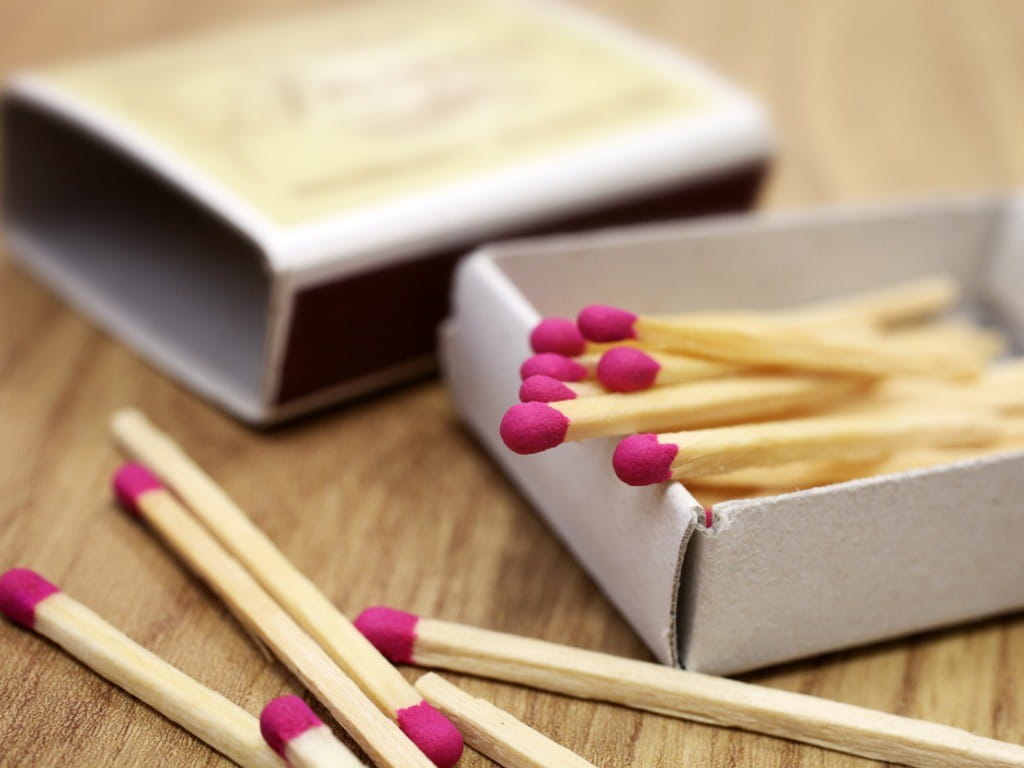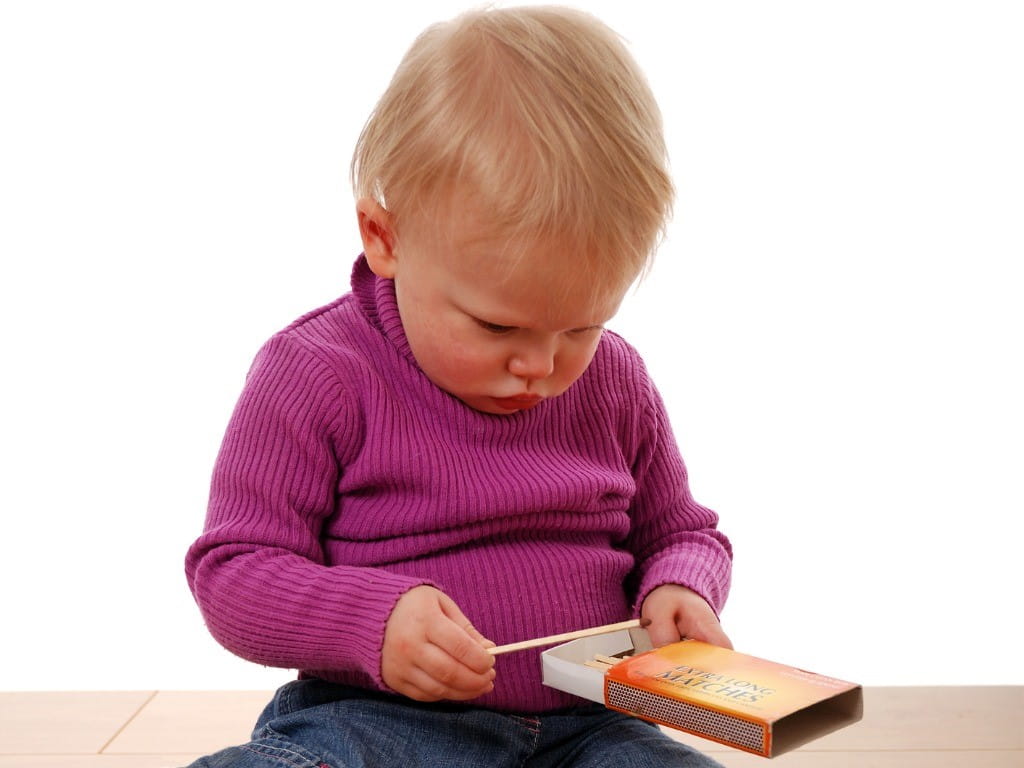My Child Just Ate a Match! Is It Dangerous?

The Bottom Line
Unintentionally swallowing a few match tips is not dangerous but would be expected to cause some minor irritation to the mouth and stomach. Swallowing a large number of matches can cause serious effects including damage to red blood cells and organs such as the kidneys and liver.

The Full Story
Matches are made from small sticks of wood or cardboard coated on one tip with ignitable materials. The match tip is struck across a suitable surface to ignite the match. Typically, matches are packaged in books of 20 cardboard sticks or boxes containing varying quantities of wooden sticks. The two main classifications, based on the required strike surface, are strike-anywhere matches (sometimes called friction matches) and safety matches (sometimes called strike-on-box matches).
Strike-anywhere matches can be ignited by striking the tip on a variety of hard, rough, and dry surfaces such as a rock, brick, or hardened concrete. Safety matches will only ignite when struck against a specially prepared surface, which is usually found on the match book or box.
Depending on the match type, the tips can contain potassium chlorate, potassium dichromate, sulfur, and phosphorus sesquisulfide. Friction and the resulting chemical reaction are responsible for the flame. Strike-anywhere matches contain all the necessary reactive chemicals on the tip of the wood stick. Safety matches place the phosphorous-containing chemical on the strike surface, which effectively eliminates the chance for spontaneous ignition.
Although fatal fires have happened when children play with matches, the main toxic concern involves swallowing the match tip. The wood or cardboard stick is generally considered non-toxic, although it could be a choking hazard. Toxic effects can occur with most of the chemicals on a match tip, but the most concerning substances are potassium chlorate and potassium dichromate.
For children, swallowing a few match tips generally causes some minor gastrointestinal symptoms such as irritation to the mouth or throat, nausea, vomiting, and diarrhea. These effects are well tolerated unless the vomiting and diarrhea are severe and lead to dehydration. Obviously, if the match tip was still hot, a burn on the lips or in the mouth might occur.
Deliberate ingestion of large numbers of matches can occur in attempts to self-harm as well as individuals with cautopyreiophagia, which is a type of pica that involves swallowing burnt match heads. One of the toxic effects with large ingestions of matches is hemolysis, which is a breakdown of the red blood cells. This causes a decreased ability to transport oxygen around the body. In addition to respiratory failure, damage to kidneys and liver can occur.
Serious toxicity from swallowing matches can happen in young children who swallow more than 12 strike-anywhere matches or more than 20 safety matches. Serious toxicity can also happen in people weighing more than 50 kg (110 lbs) who swallow more than 80 strike-anywhere or safety matches. For example, a 3-year-old boy developed kidney failure after eating about 40 match heads. In a unique situation of a pregnant woman with cautopyreiophagia, her newborn daughter showed toxic effects of exposure to the chemicals from the matches. The newborn had hemolysis of her red blood cells and signs of liver injury. She required treatment in a hospital for eight days.
The treatment for ingestion of match heads is to rinse and spit with water to remove any remaining material found in the mouth, drink a few sips of water, and watch for dehydration if vomiting or diarrhea occurs. Minor vomiting or diarrhea can be managed at home by increasing fluid intake. Dehydration from severe vomiting or diarrhea as well as burns in the mouth require medical evaluation. Anyone deliberately swallowing matches should receive medical evaluation.
If you suspect someone has swallowed match tips, check the webPOISONCONTROL® online tool for guidance or call Poison Control at 1-800-222-1222.
Karen D. Dominguez, PharmD
Certified Specialist in Poison Information
Poisoned?
Call 1-800-222-1222 or
Prevention Tips
- Keep unlit (and lit!) matches out of reach of children.
- Discard used matches as soon as it is safe to do so.
- Help keep matches out of the hands of curious children by teaching them to tell an adult when they find matches in their environment or in the hands of another child.
This Really Happened
The mother of a 16-month-old boy called Poison Control because the boy was found sucking on a whole book of paper matches. No matches were missing from the book. He was fine and had been given water to drink, but she wanted to know if the boy needed to be taken to an emergency room. Poison Control was able to determine that the boy could be managed at home. The mom was provided with a list of possible effects that could occur, such as irritation to the mouth or throat or vomiting. Poison Control contacted the mom a few hours later to check on the boy. The boy did not develop any effects, and an unnecessary trip to an emergency room was avoided.
For More Information
Public education. Quincy (MA): National Fire Protection Association; [cited 01 Mar 2019].
References
Poisoned?
Call 1-800-222-1222 or
Prevention Tips
- Keep unlit (and lit!) matches out of reach of children.
- Discard used matches as soon as it is safe to do so.
- Help keep matches out of the hands of curious children by teaching them to tell an adult when they find matches in their environment or in the hands of another child.
This Really Happened
The mother of a 16-month-old boy called Poison Control because the boy was found sucking on a whole book of paper matches. No matches were missing from the book. He was fine and had been given water to drink, but she wanted to know if the boy needed to be taken to an emergency room. Poison Control was able to determine that the boy could be managed at home. The mom was provided with a list of possible effects that could occur, such as irritation to the mouth or throat or vomiting. Poison Control contacted the mom a few hours later to check on the boy. The boy did not develop any effects, and an unnecessary trip to an emergency room was avoided.
